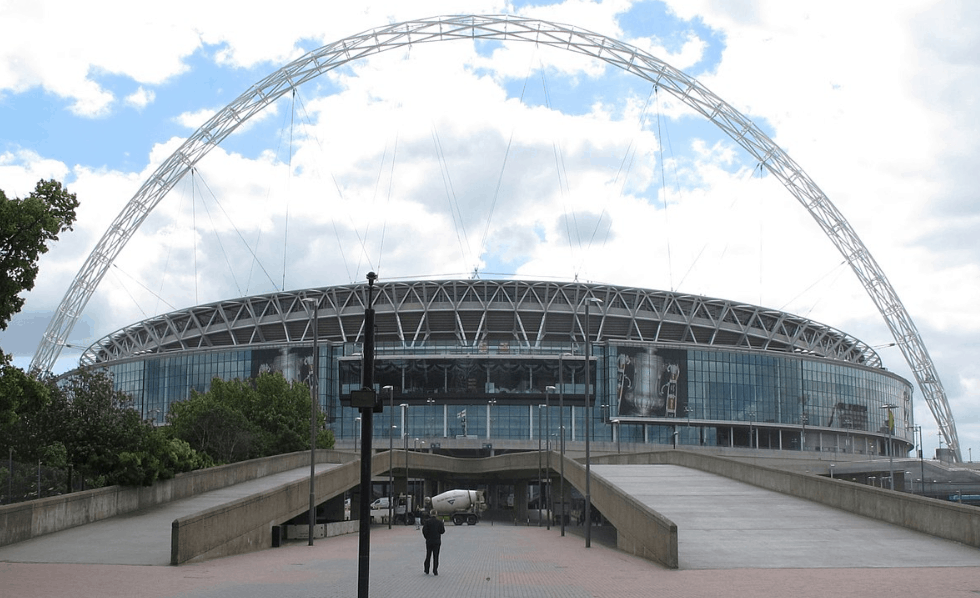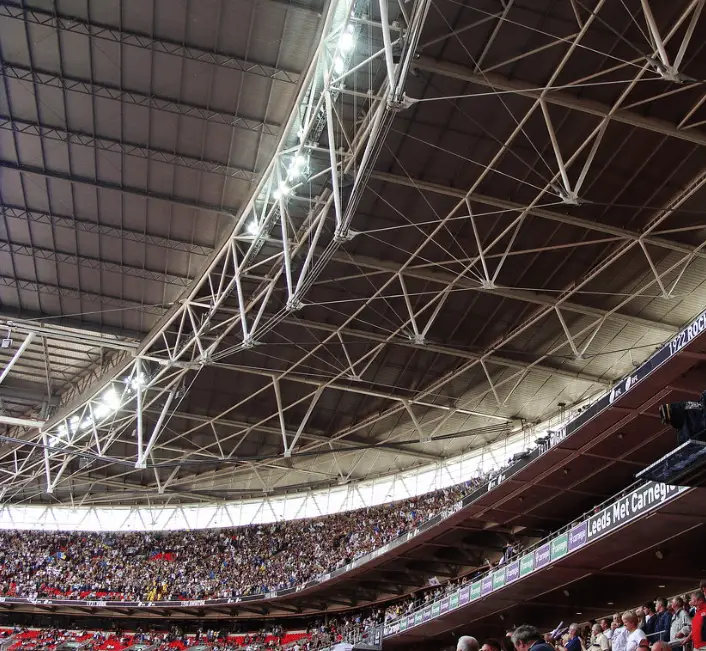It’s the biggest football stadium in the United Kingdom and holds a remarkable spot in sports history.
In this post, you’ll discover the ultimate list of facts about Wembley Stadium, a sports temple that has plenty of amazing stories to tell.
1. It’s more than a football stadium
Wembley Stadium, which is located in the town of the same name in the northwest of London, is best known for hosting Association Football games (or soccer games as it’s called in 9 countries) of the English National team and cup finals.
Apart from important football matches, it’s also used as a venue for multiple other sports, including Rugby, American Football, and Boxing, as well as a venue for artists to hold concerts.

2. It is home to the headquarters of the FA
The stadium is actually owned by the FA (Football Association), which is the governing body of Association Football in England.
For this reason, the FA has set up a subsidiary company to manage the stadium called the “Wembley National Stadium Ltd.” (WNSL).
The headquarters of the FA is located within Wembley Stadium.

3. It holds a couple of records
With a total capacity of 90,000 spectators, Wembley Stadium is the biggest stadium in England and the United Kingdom.
It’s also the second-biggest stadium in Europe behind the Camp Nou of FC Barcelona, which has a capacity of nearly 100,000.
We didn’t include the stadium in our list of biggest football stadiums in Europe, because it’s not the stadium of a particular club but rather a national stadium.

4. It was designed by two renowned architectural firms
The design of the stadium was in the hands of two internationally renowned architectural firms, Foster and Partners and HOK Sport (now known as Populous).
Populous is an international company with headquarters in Kansas City that specializes in the design of sports stadiums and has designed stadiums all around the world, including the new “Tottenham Stadium” and numerous stadiums for multiple sports.
Foster and Partners is a London-based architectural firm led by founder and chairman Norman Foster and has designed various types of projects. These include for example the Millennium Bridge in London, The Reichstag Building in Berlin, and the Varso Tower in Warsaw, Poland (which will become the tallest skyscraper in the European Union upon completion).

5. Wembley Stadium was constructed by Australians (and they surely regret it)
The main contractor of the stadium was the Australian construction company “Multiplex.” Their most famous projects are “The Emirates Towers” in Dubai, and “Australia 108” in Melbourne, the tallest building in Australia.
What should have been one of their most prestigious projects actually turned out to become a major fiasco.
Because of multiple delays (construction started in 2002 instead of 2000), multiple accidents, and multiple issues with various companies they worked with on the project, Multiplex actually lost a lot of money on the construction of Wembley Stadium.
Multiple lawsuits after construction were completed reduced their loss from £183 million to £148 million, which is probably not something they celebrated.

6. It was one of the most expensive sports stadiums ever constructed
If you see how much loss Multiplex made, it’s easy to assume that the total cost to build the stadium was enormous.
And it as. The total cost to build Wembley Stadium, excluding the loss made by Multiplex, is estimated to have been £789 million, which is the equivalent of over £1.2 billion today!

7. The stadium has a special design feature
One of the most prominent features of the stadium is its circular section lattice arch which supports 100% of the roof on the north side and 60% of the retractable roof on the south side.
The arch has an internal diameter of 7 meters (23 feet), a total span of 315 meters (1,033 feet), and reaches a total height of 133 meters (436 feet).
These dimensions make the arch of Wembley Stadium the world’s longest unsupported roof structure.

8. The old iconic stadium was demolished
To build the new Wembley Stadium, the old iconic Wembley Stadium needed to be demolished. The old stadium had been the national stadium for nearly 80 years (it was constructed in 1922-1923) when the plans for the new stadium were released in 2000.
The plans were delayed though due to various legal and financial problems, and the demolition of the iconic “twin towers” of the old stadium started in December 2002.
Inside the Old Wembley Stadium

Old Wembley twin tower

9. There were multiple issues during construction
Apart from the delays regarding the starting date of construction, there were various other problems as well.
One of the sub-contractors, “Cleveland Bridge,” suddenly withdrew from the project and had to be replaced by Dutch firm “Hollandia.”
There was also a huge issue regarding safety as a fatal accident happened in 2004 when a carpenter lost his life after a scaffolding platform collapsed on top of him.
Something similar, without casualties, happened in 2006 when a steel part of the roof collapsed, resulting in 3,000 construction workers having to evacuate the site.
All these issues resulted in the construction of the stadium being delayed until March 9, 2007, even though construction had officially started on September 30, 2002.

10. Excavations uncovered an amazing surprise
Before the old Wembley was constructed in the early 1920s, another project had been constructed on the location of the stadium.
At least, an attempt was made!
The level of the pitch of the new stadium was lower than the old one, so the engineers had to excavate a bit deeper and stumbled upon the remains of the foundation of the “Watkin’s Tower.”
This tower, which was also referred to as “The Wembley Tower,” was a failed attempt to recreate a bigger version of the “Eiffel Tower” of Paris in London. The tower was supposed to have a height of 358 meters (1,175 feet) but construction was halted at just 47 meters (154 feet).
The project was shelved after the company that had started it failed financially in 1899, and the Old Wembley Stadium was eventually built on top of its foundations.

11. An illustrious footballer is looking down Wembley Lane
Just as Manchester United commemorates football legends with statues just outside of Old Trafford, so does the FA regarding a legend who played in the English football shirt.
A statue of Bobby Moore, the legendary captain of the English National football team that won the FIFA World Cup in 1966 is looking down Wembley Lane and welcomes visitors to the stadium.
It was Sir Bobby Charlton who unveiled the statue of Bobby Moore on May 11, 2007, a week before the official opening of the New Wembley.

12. The pitch itself didn’t do justice to the amazing stadium
With one of the most admirable football arenas in the world completed, all English football fans had something to be immensely proud of.
This was, however, until games were being played at the new stadium. The pitch itself has been described as being unworthy of important games being played on it and was even blamed for the non-qualification of the English football team for the UEFA Euro 2008 Championship.
Between 2007 and 2010, the pitch had been relaid 10 times without a positive result. Up until today, the pitch is being criticized as there seems to be no solution to recreate the perfect pitch that the old stadium was famous for.

13. The sliding roof has a special function
The roof covers a total area of 40,000 square meters (430,000 square feet), and about 13,722 square meters (147,700 square feet) are movable.
The reason that a movable roof was installed was to allow sunlight to reach the grass of the pitch. Grass needs direct sunlight to grow and be healthy, so the roof on the east, south, and west can be pulled back to minimize the shade.
During the first Cup Final though in 2007 it became clear that the movable area of the roof wouldn’t suffice as part of the pitch was in the shade at 3 pm, resulting in the problems that would follow over the next years.

14. Somebody actually wanted to buy Wembley Stadium in 2018
The owner of “Fulham F.C.” and the “Jacksonville Jaguars,” Shahid Khan, was convinced he could actually buy Wembley Stadium in April 2018.
After multiple meetings, Shah eventually ended up withdrawing his £600 million bid after he found out that there was some opposition to the deal.

15. Wembley hosted a regular-season NFL game
One of the most amazing facts about Wembley Stadium is that it was the venue of the first-ever regular-season NFL game to be held in Europe and even outside of North America on October 28, 2007.
The New York Giants defeated the Miami Dolphins by a score of 13–10 in a historical game in front of 81,176 spectators.
Since this game, multiple NFL regular-season games have been hosted in the Wembley Stadium.

16. Tottenham used it as their home ground for nearly 2 seasons
Tottenham Hotspur is a London-based football club that recently built a new stadium, the “Tottenham Hotspur Stadium.” To do so, they had to demolish their old stadium at White Hart Lane in London.
Because of this, they played their home matches during the entire 2016-2017 and 2017-2018 seasons at Wembley during the construction phase of their new home.

17. 90,000 people once watched a boxing match at Wembley Stadium
Boxing is another sport that is often hosted at Wembley Stadium. the heavy-weight championship fight between Anthony Joshua and Wladimir Klitschko was held in the stadium on April 29, 2017.
During this game, approximately 90,000 boxing fans saw Joshua beat Klitschko after a Technical Knockout, an absolute record attendance for a boxing match.

18. Multiple famous artists have performed at Wembley Stadium
The stadium is often used for concerts of famous artists from all around the world. The list of artists that performed inside the stadium is pretty extensive.
Metallica, The Killers, Green Day, Foo Fighters, Eminem, Madonna, Taylor Swift Beyoncé, Coldplay, Oasis, Take That, BTS, AC/DC, Adele, Elton John, and the Spice Girls have all performed at Wembley.

Quick facts about Wembley Stadium
19. The stadium can hold 90,000 spectators and has 166 executive suites.
20. The record attendance was set during an FA Cup Final between Portsmouth and Cardiff City on May 17, 2008, when 89,874 people watched the game.
21. The concert of Adele in June 2017 was visited by 98,000 people which is the highest attendance ever in the stadium.
22. It holds the record for most toilets in any venue, with a total of 2,618.
23. The bowl volume of the stadium is 1,139,100 cubic meters, which is actually less than the Millennium Stadium in Cardiff.
24. The circumference of the stadium is approximately 1 kilometer (0.62 miles).
25. At one point, a total of 3,500 construction workers were busy working inside the stadium.

26. 90,000 cubic meters (120,000 cubic yards) of concrete were used during construction.
27. 23,000 tonnes (25,000 short tons) of steel were used to build the stadium.
28. The stadium is supported by a foundation that consists of 4,000 separate pillars, the deepest going 35 meters (115 feet) into the ground.
29. The pitch size is 115 yards (105 meters) long by 75 yards (69 meters) wide.














